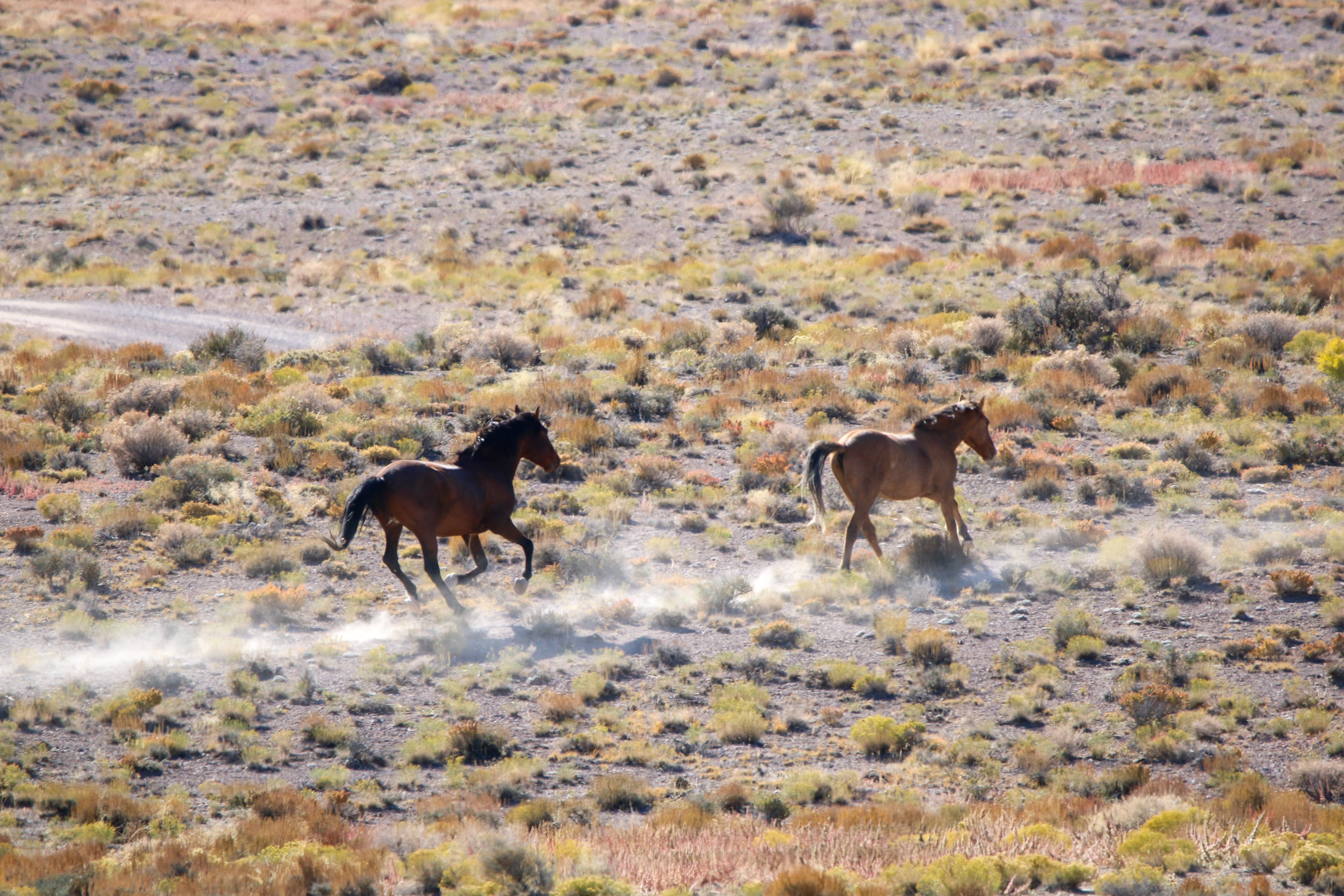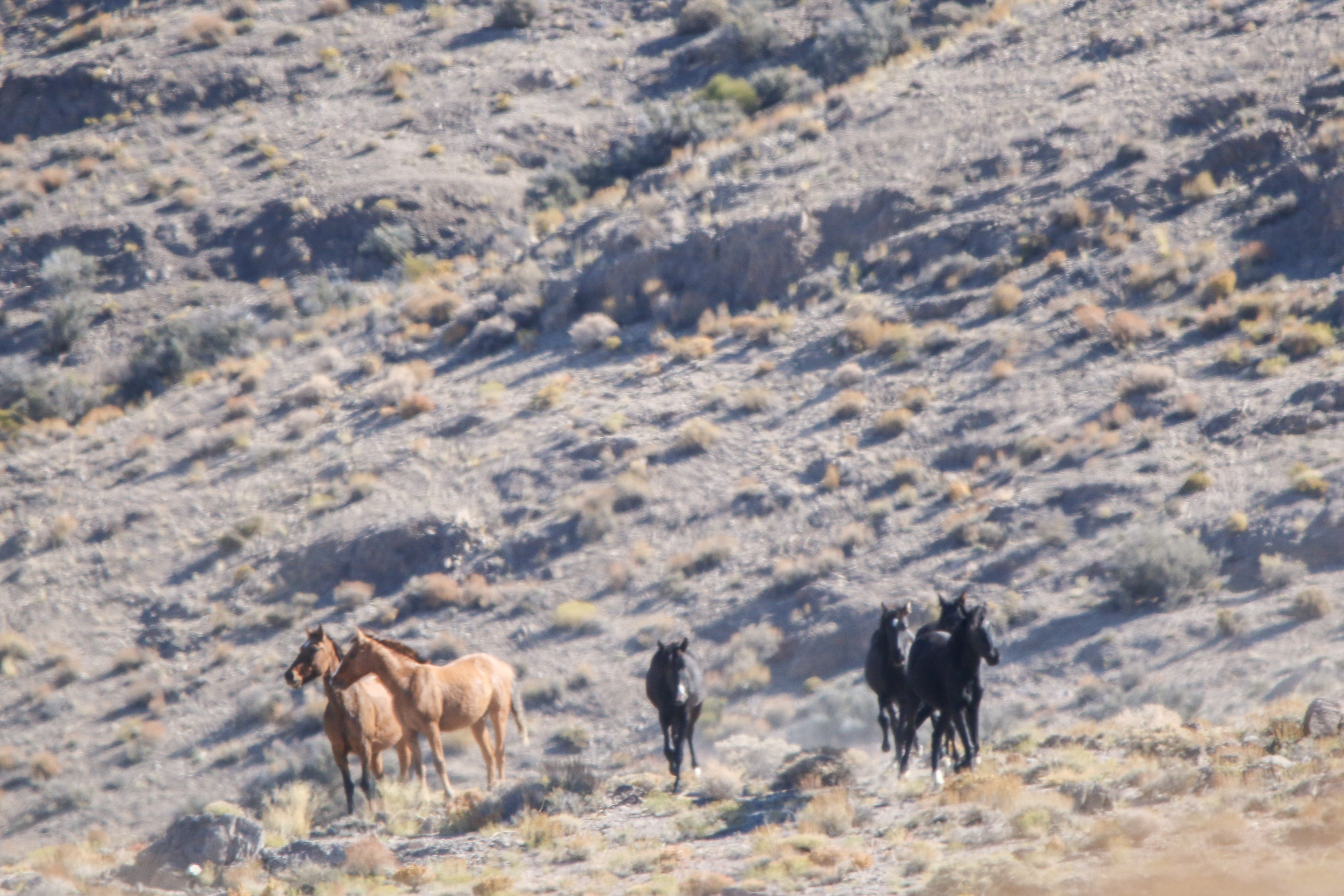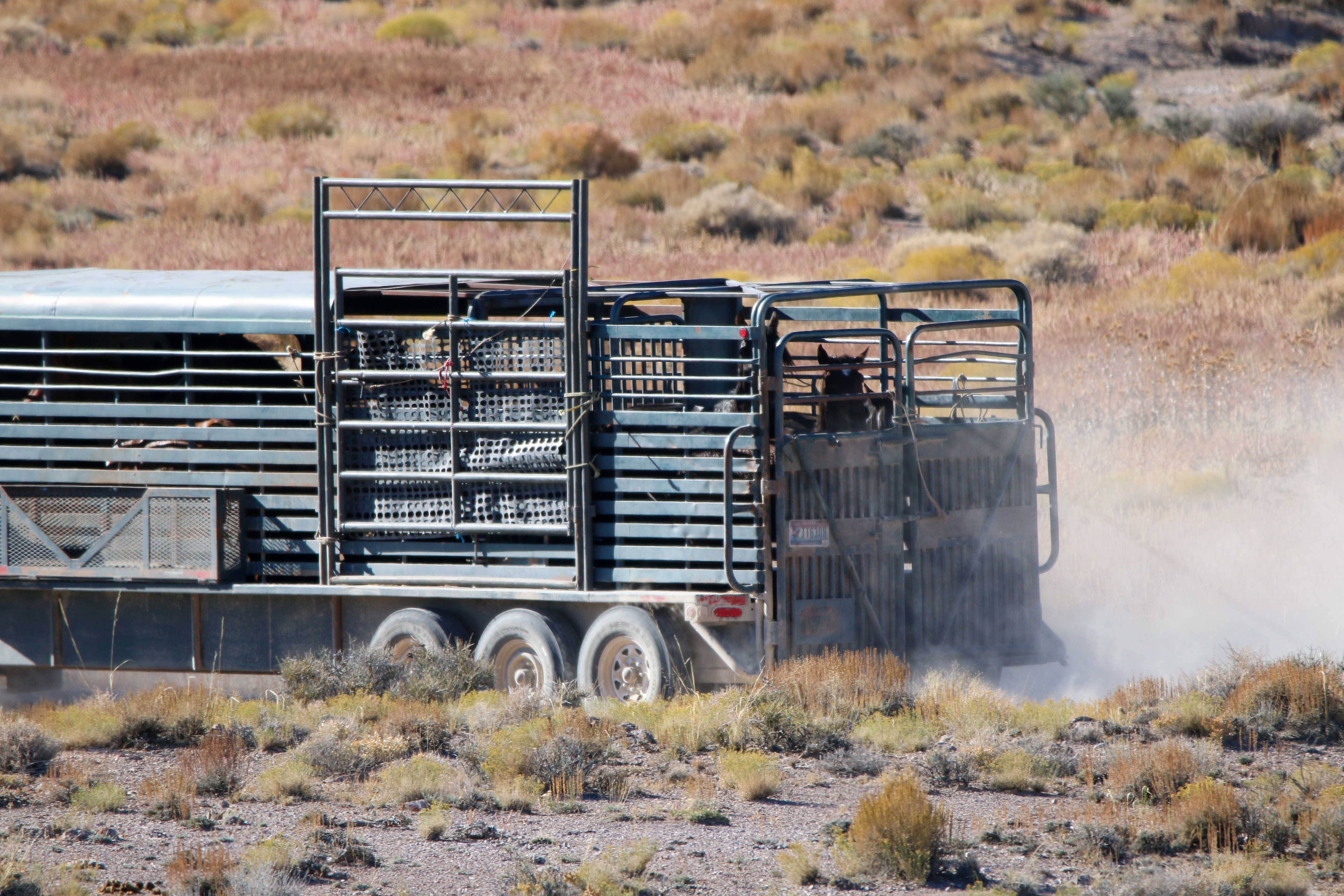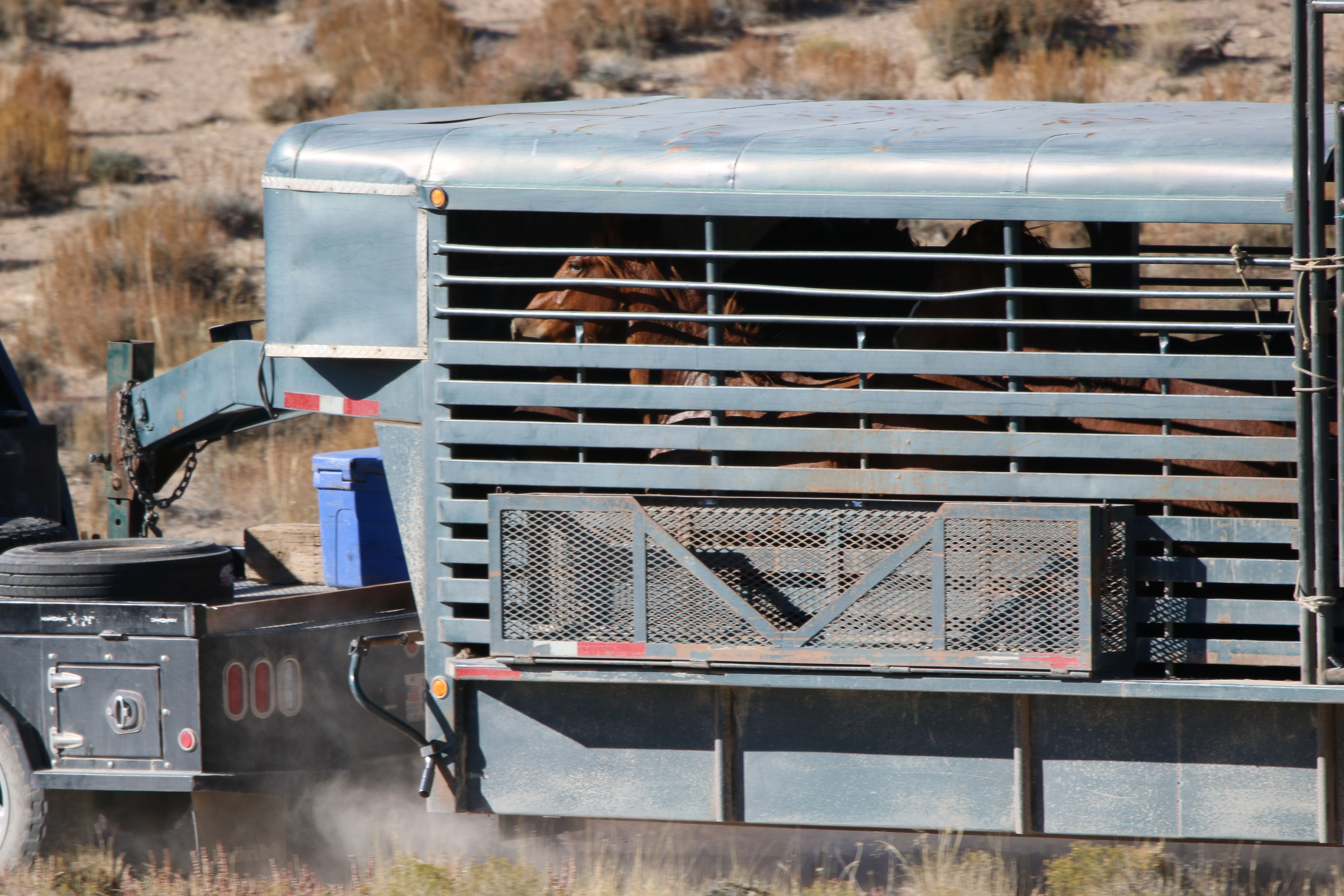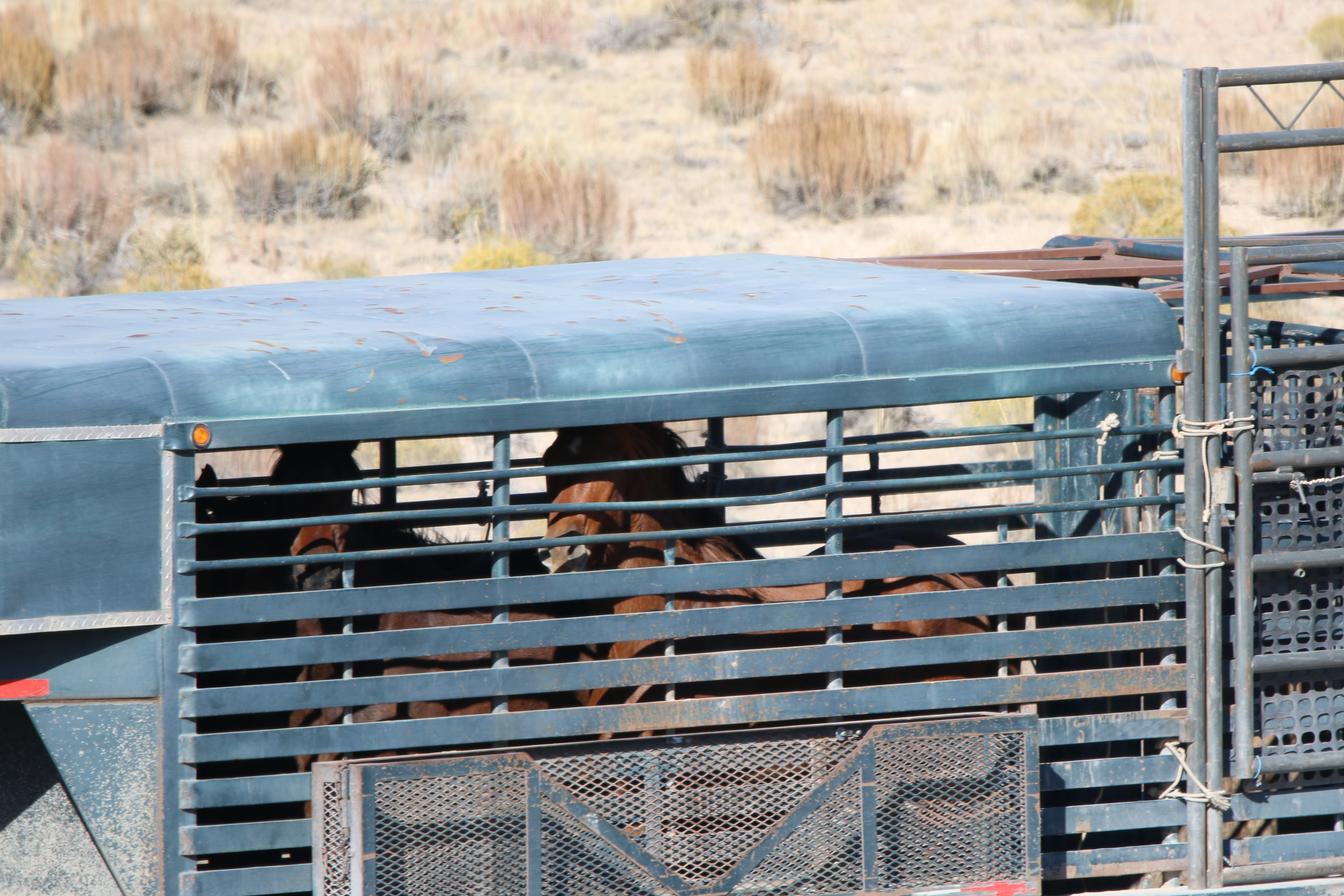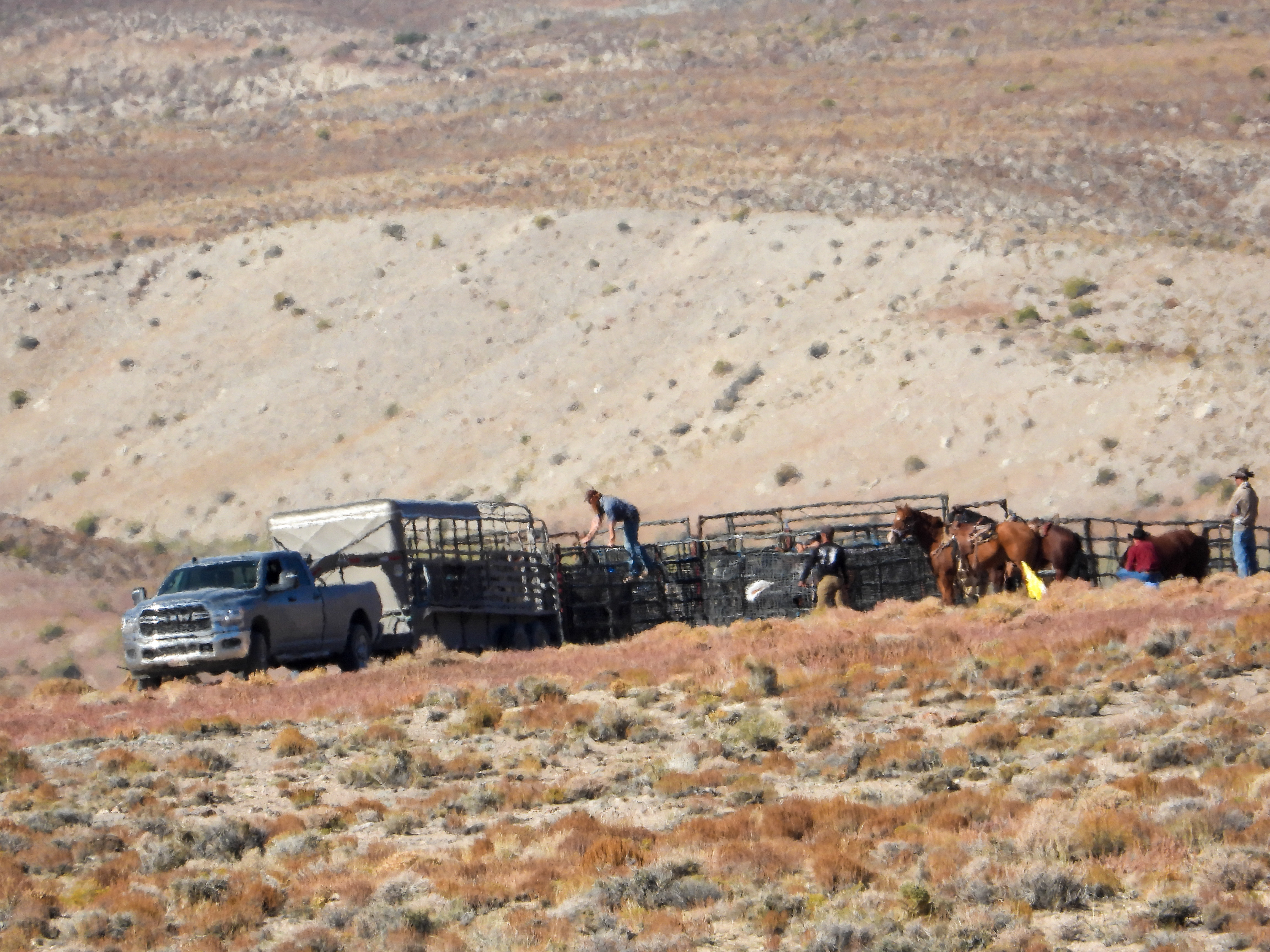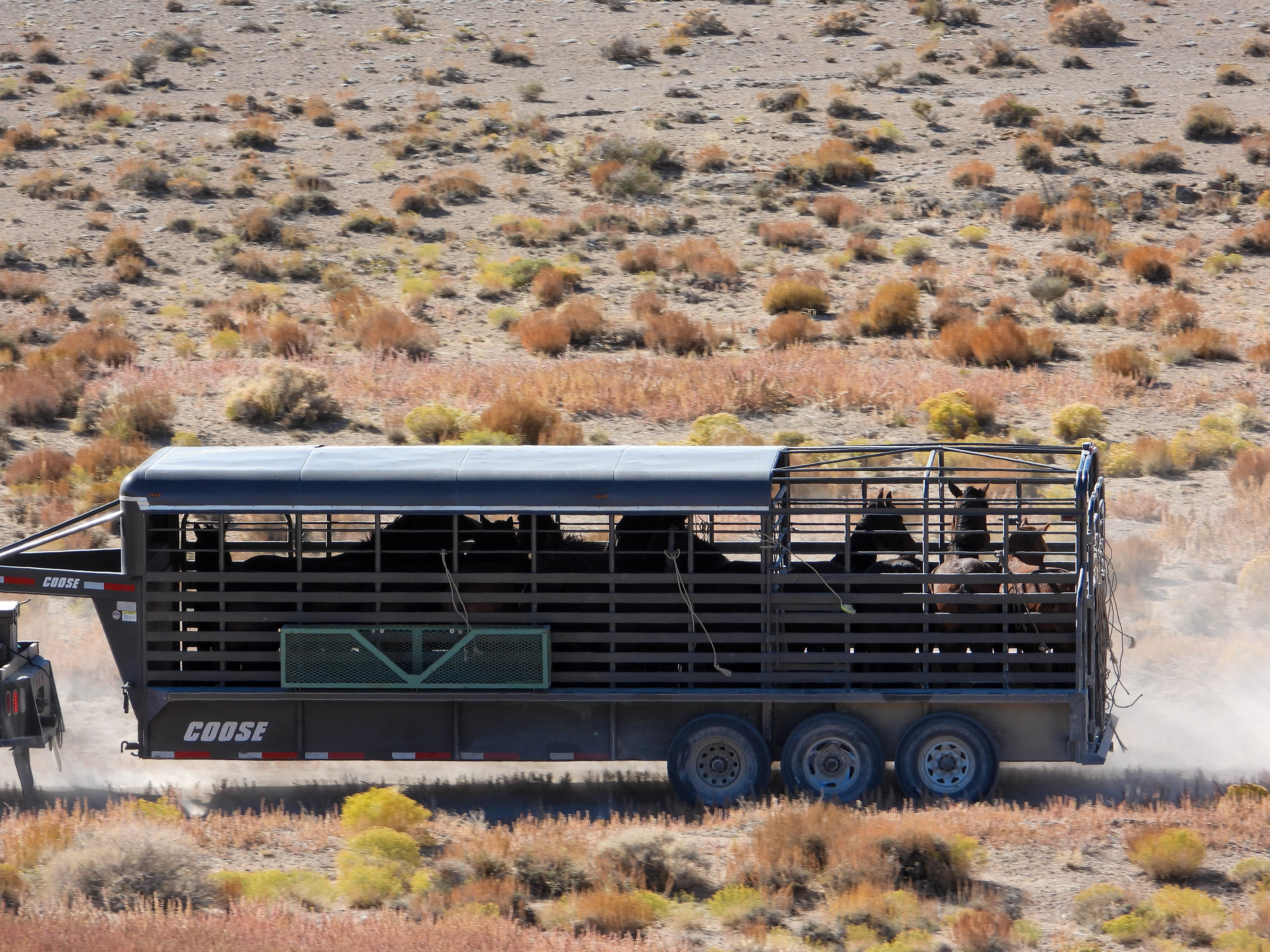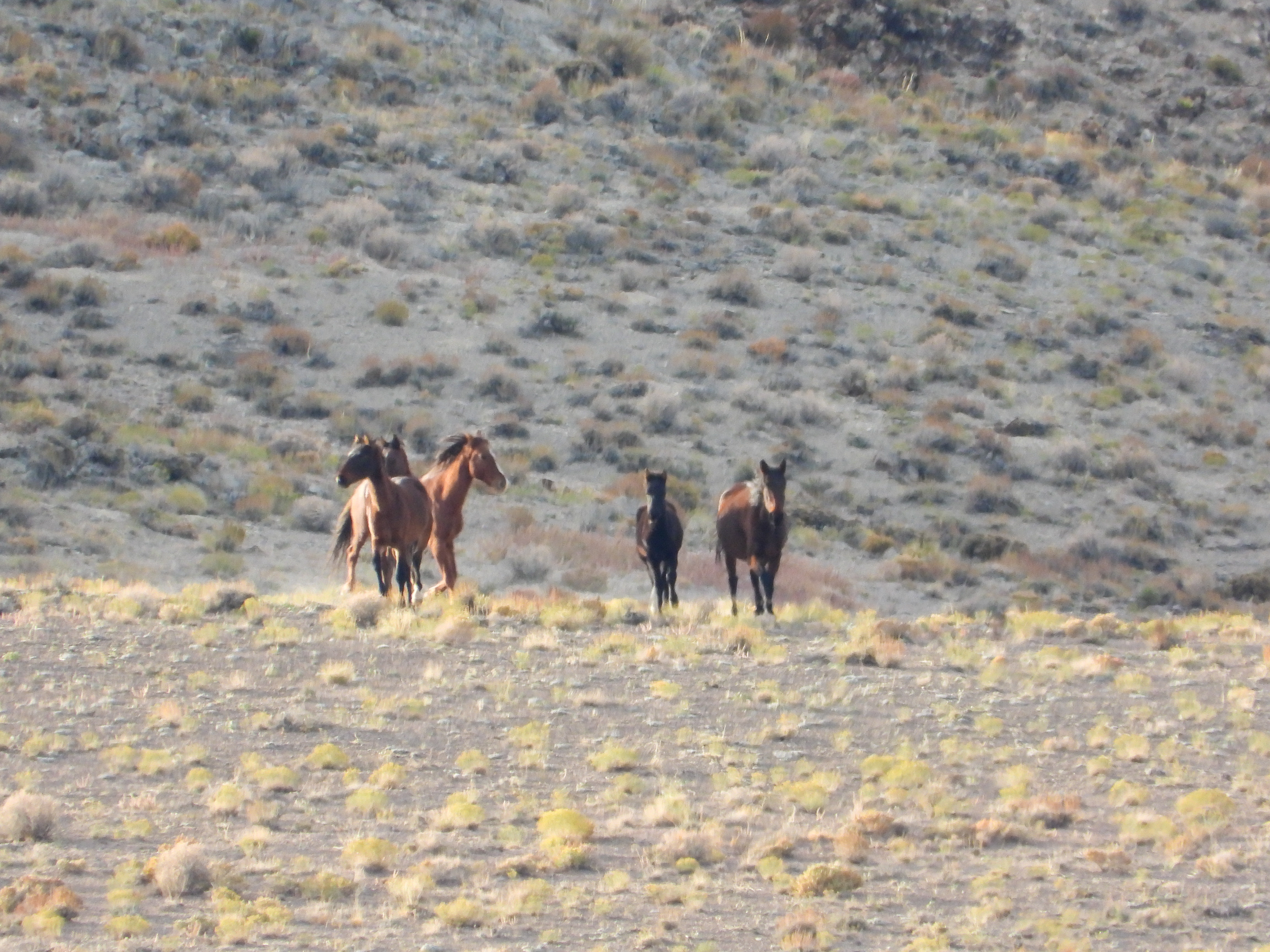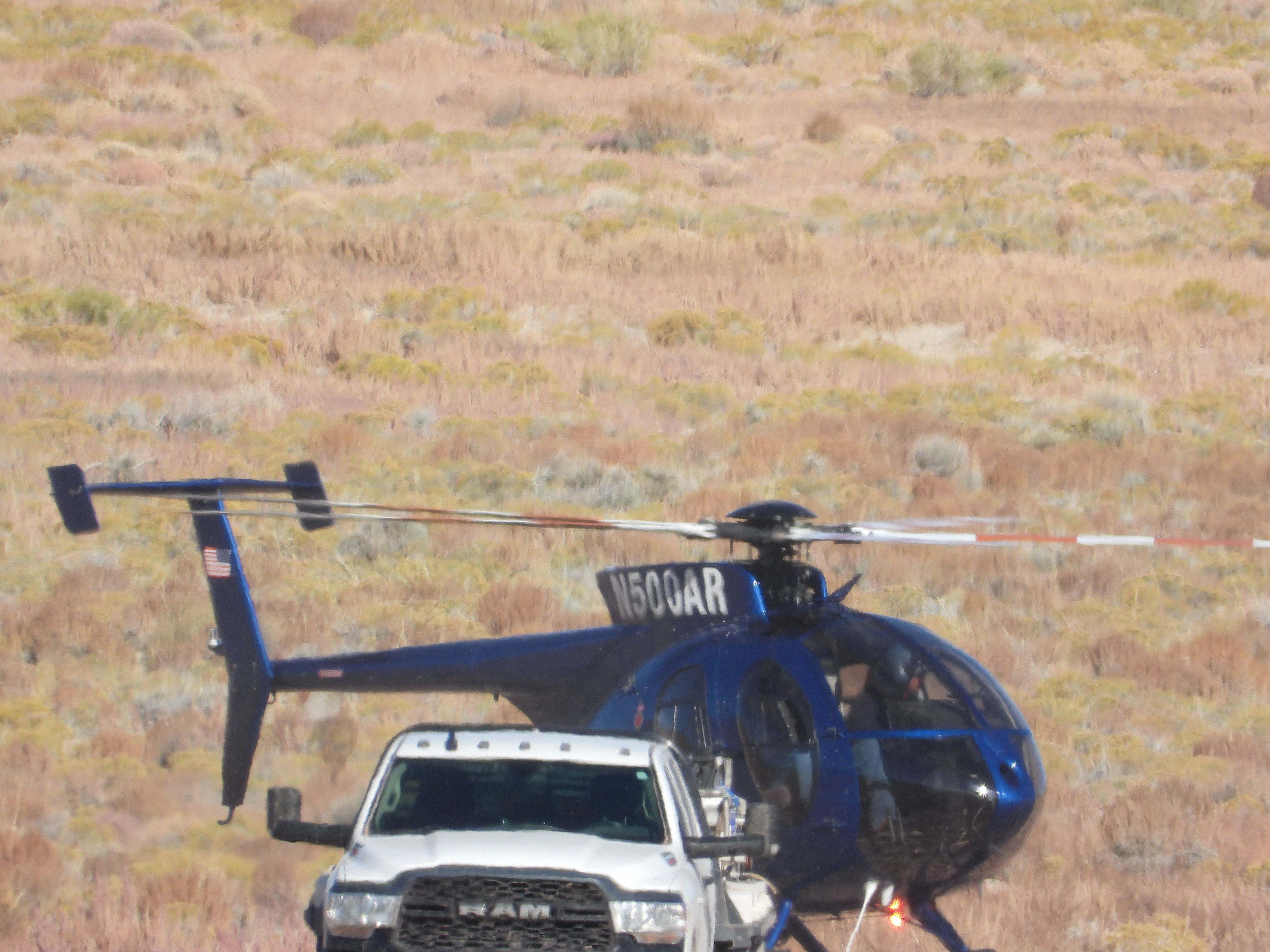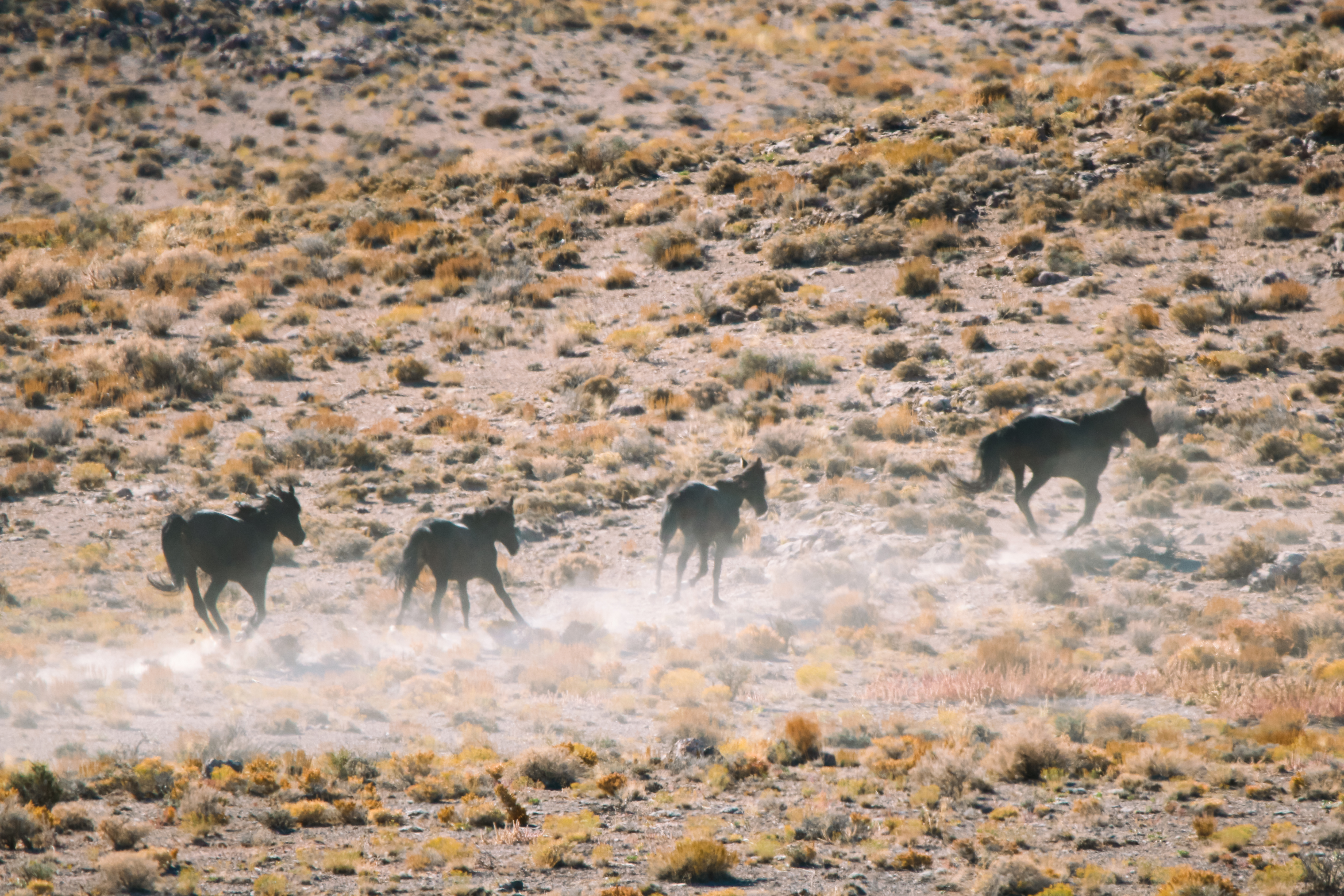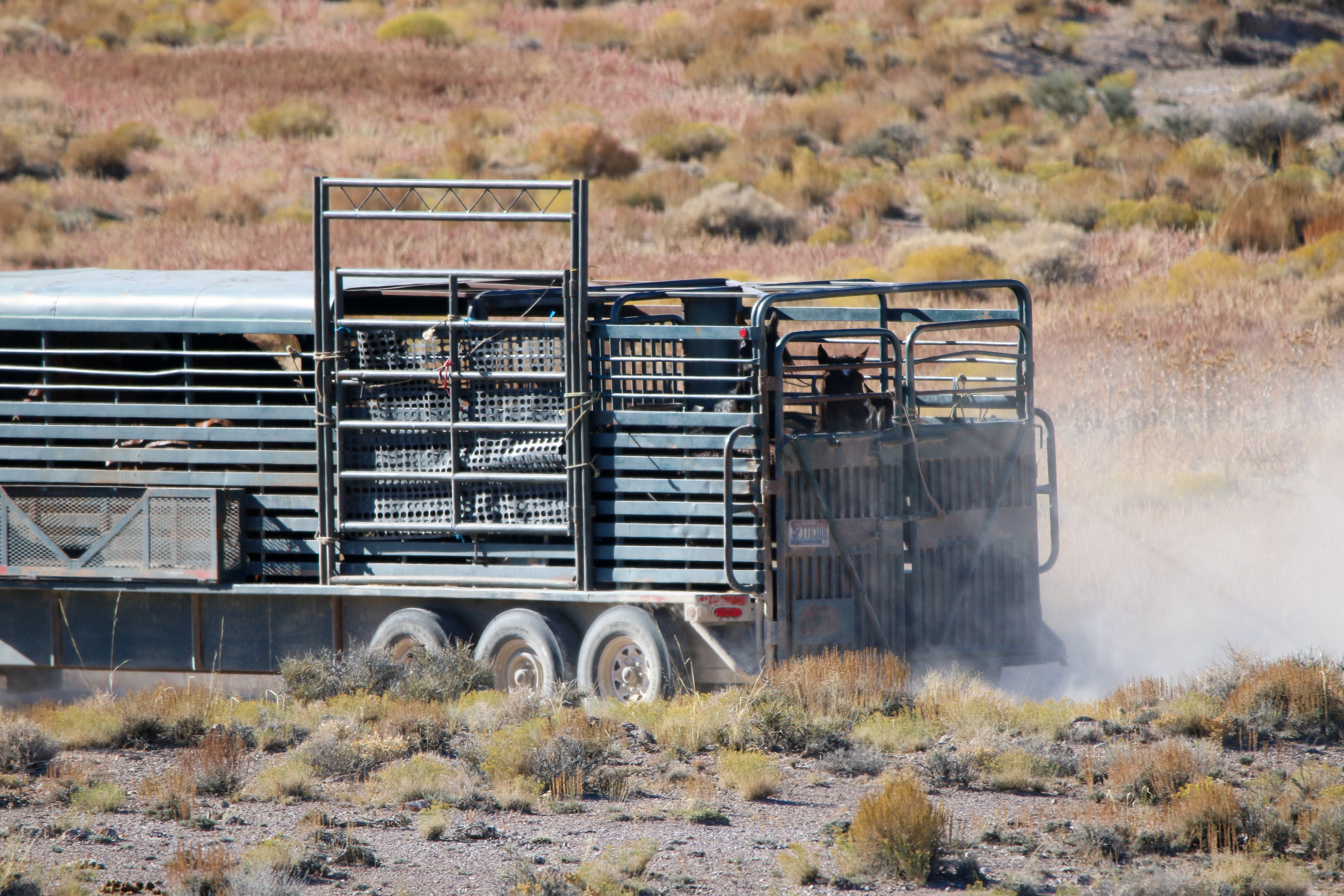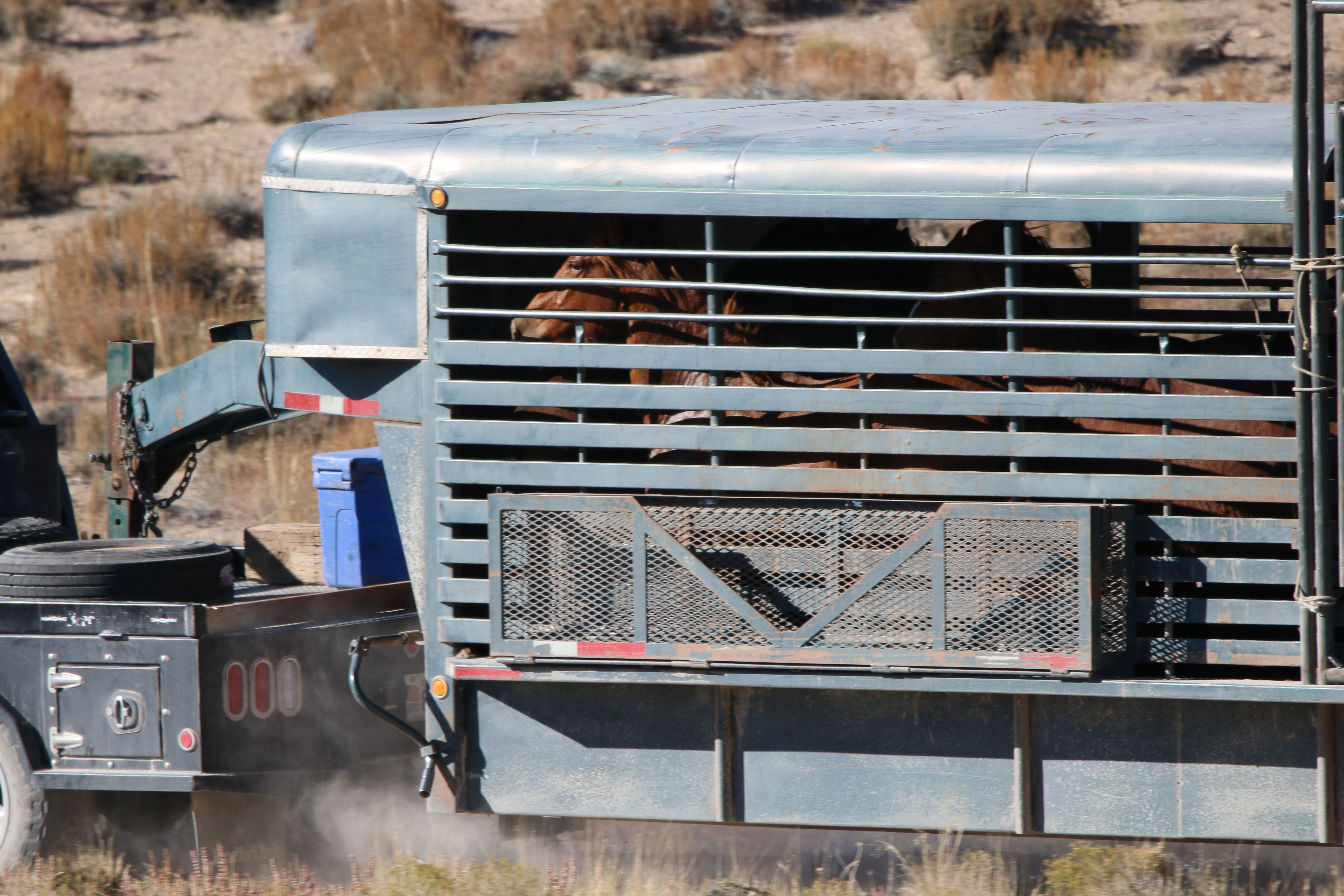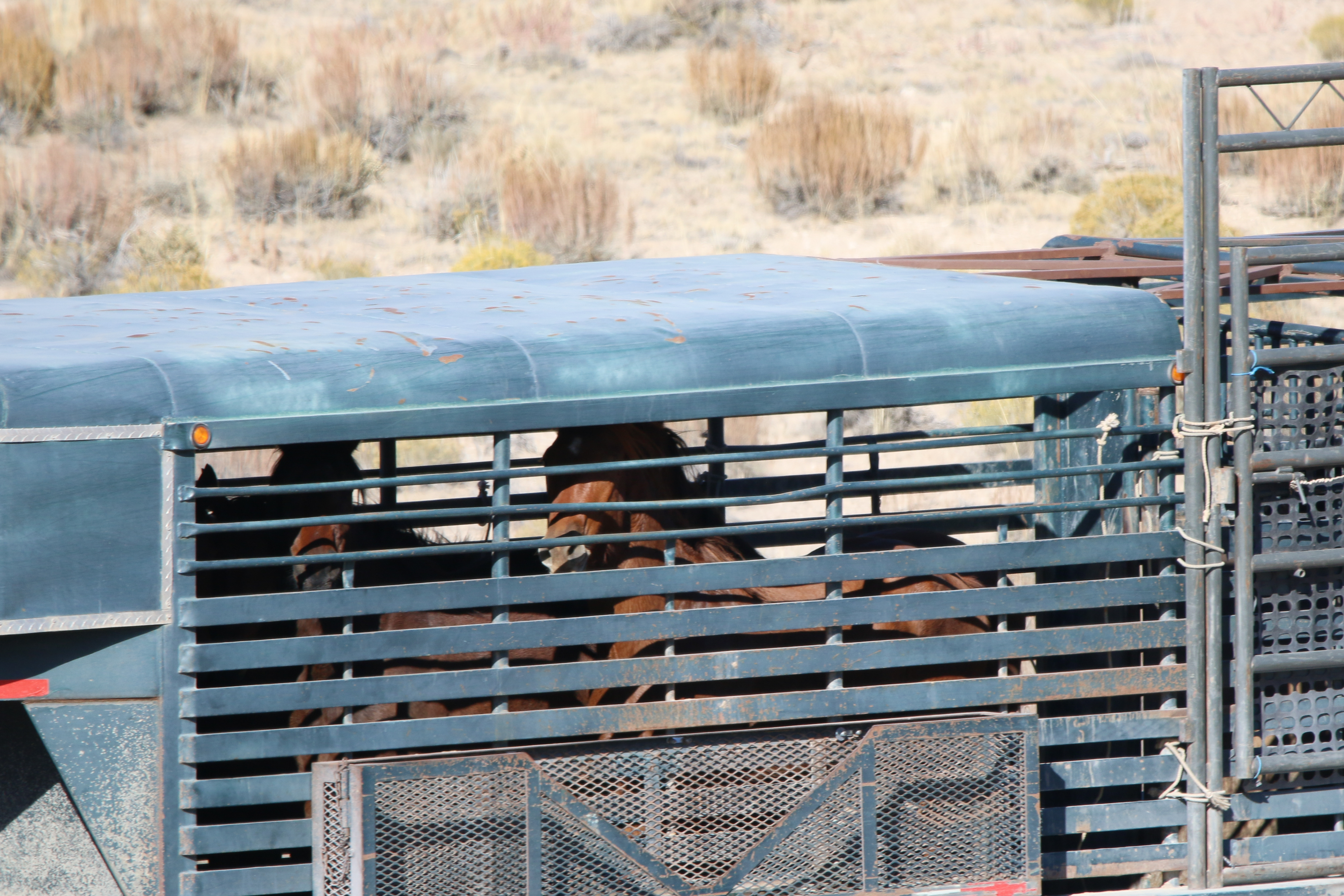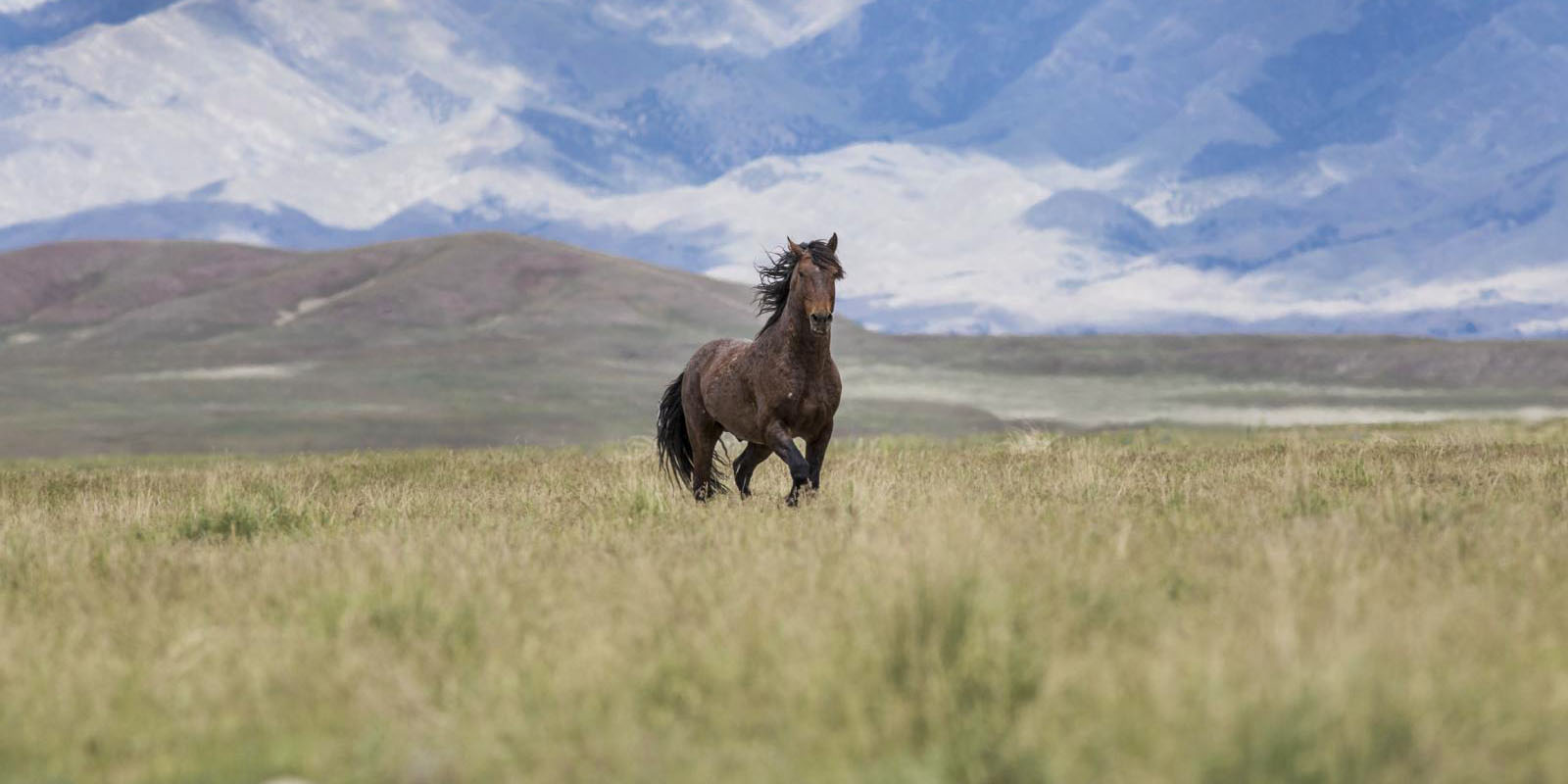On October 17, 2023, the Bureau of Land Management (BLM) will begin a roundup and removal of more than 400 wild horses from the Moriah Herd Area, 48 miles north of Ely, Nevada. Notorious helicopter contractor Cattoor Livestock will be conducting the operation.
ROUNDUP REPORT
The roundup has concluded with 440 wild horses removed, 2 deaths.
October 22, 2023
We met BLM personnel at the BLM Ely District office at 5:30am, and it was 39°. We then traveled 73 miles to the observation site, arriving at 7:30am. We waited for instructions on where to observe and for the contractors' ground crew to arrive.
The trap was set at an unusual angle, making it difficult to assess. However, when the horses arrived, it seemed like there was enough space. Sometimes, on the last day of the gather, they have a smaller team and may not put as much effort into setting up the trap. As the horses came in, the trap and run area were being watered down to minimize dust.
The first run, consisting of 5 horses, was brought in by helicopter at 8:53am. The second run, with approximately 16 horses, came in at 9:15am. The pilot had to maneuver a large group back and forth before finally getting them into the wing area. The last run was brought down from the saddle behind us, and the group was run into the trap, but we couldn't see it from our location. The last two groups were quite large, so they were the final runs for this roundup.
On our way back to the temporary holding area, the road was very rough and it took about an hour to reach it. When we arrived at the observation area, there were still horses at the trap site that trailers were leaving to load. Normally, we would have to wait for all the horses to be processed before we could do a walk around, but since it would take some time for the other trailers to return to the holding area, I was allowed to do a walk around while they were processing the last load.
At that point, I was the only member of the public at the temporary holding area. It's rare for us to be able to observe the horses up close during the processing, and it was heartbreaking to hear them crying out for one another. The foals were calling out for their mares, still waiting to be reunited. The horses were unsettled as they were being processed off the trailers. I didn't see any injuries, but the sound of their cries trying to reunite was overwhelming. There was water and hay available, and the area had room for expansion if needed.
October 21, 2023: 21 wild horses were captured and there were two deaths: a 2-year-old bay stallion was euthanized for having a clubbed foot and a 1-year-old sorrel stallion was euthanized for lameness in both front legs.
Today, we encountered a new trap location for observation. The site was situated over a mile away, atop a challenging hill where it was difficult to set up a tripod. Additionally, shooting into the sun made it even more challenging to assess the activities at the trap area. The heatwaves, starting as early as 8 am, further hindered our visibility and ability to observe. If we had been positioned closer, we would have had a better view of the entire trap and wing area.
Our day began at 5:30 am when we met with the Bureau of Land Management (BLM). We then traveled in a caravan for 46 miles to reach the observation site. By 8:00 am, the temperature was 52°F. We hiked up to the observation site, which was located on the side of a rocky hill. From there, the trap appeared to be a mile or more away. Setting up a tripod on the hill proved to be quite challenging.
At 8:45 am, the first run occurred. Three horses came running over the hill and headed towards the trap area. The wrangler maintained a steady pace until they reached the catch pen. Around 9:14 am, the pilot brought in the second run from the same location, this time consisting of five horses and a young foal/colt. A wrangler had to rope and walk the foal back to the area.
At 11:05 am, three more horses, along with a foal, were brought in. They appeared to be quite sweaty. By 12:00 pm, six more horses arrived. At 12:36 pm, two tired-looking horses walked up to the trap. Unfortunately, due to the distance from the trap, heat waves, and our position on the hillside, our stability and visibility through the camera were severely limited. Even with the naked eye, it was difficult to see anything clearly.
At 12:50 pm, we packed up and headed to the temporary holding area. By 1:25 pm, we had arrived, but all processing for the day had already been completed. The body scores of the horses observed ranged from 4 to 5. At 1:40 pm, we concluded our day, knowing that a new trap location awaited us tomorrow.

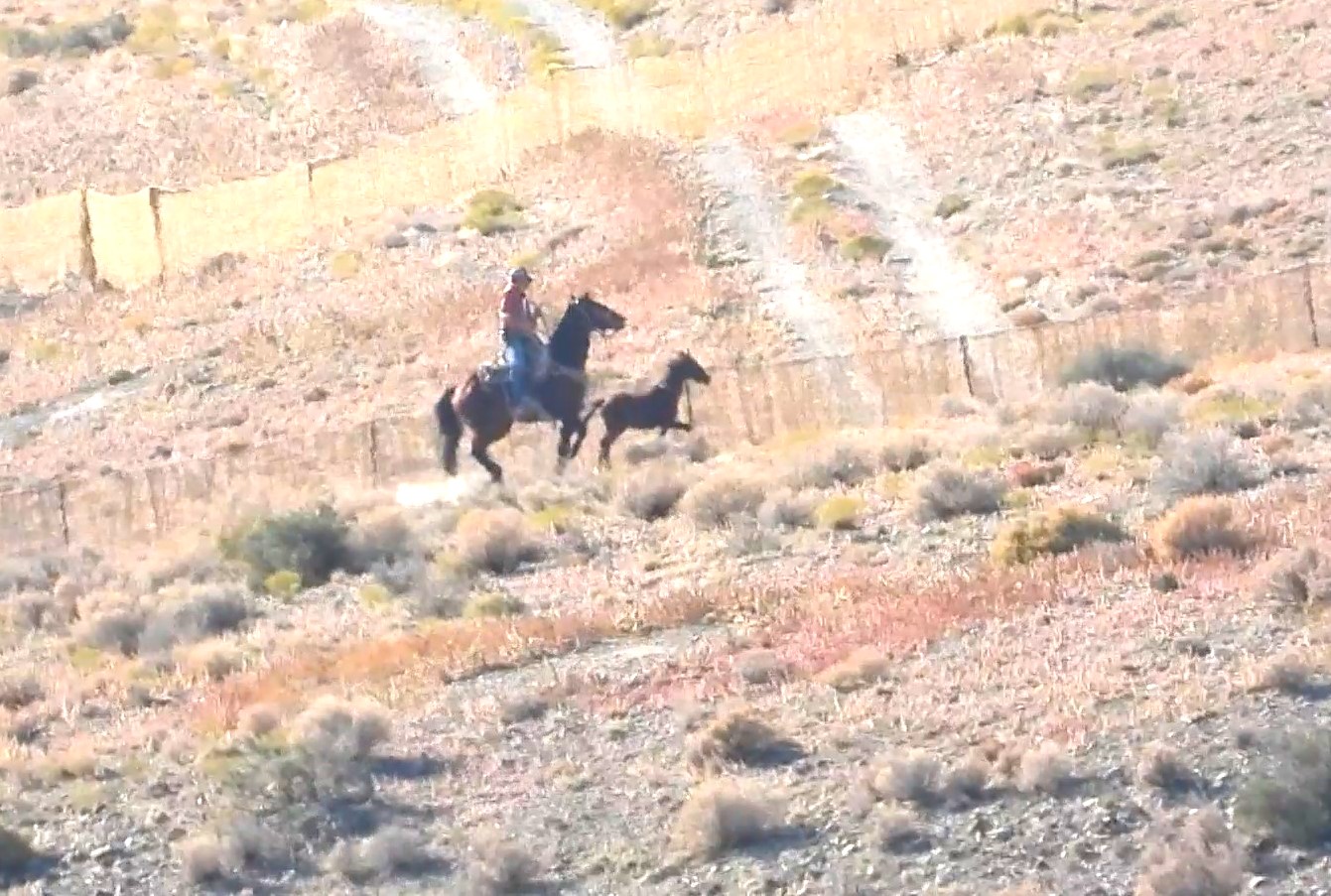
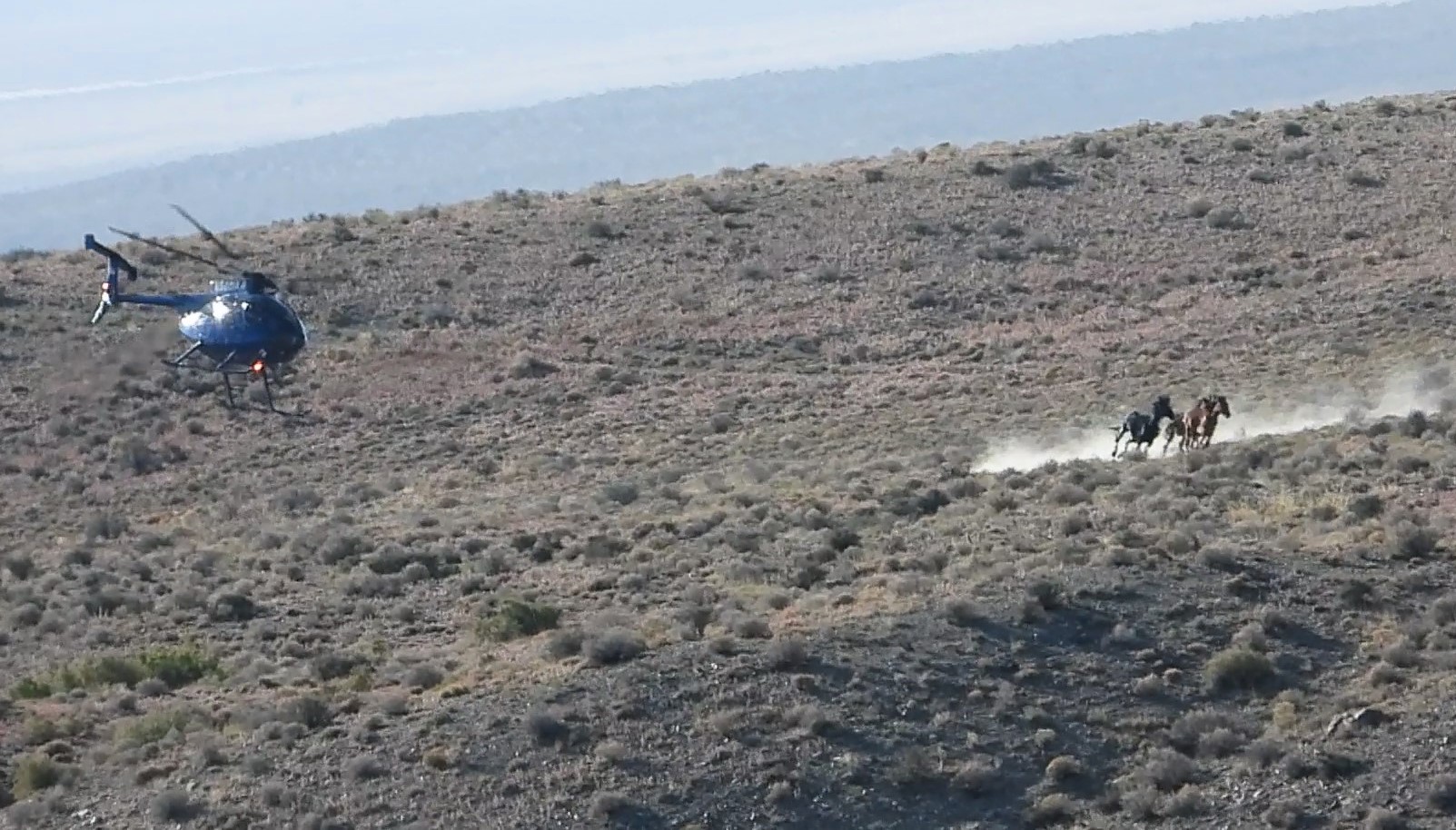
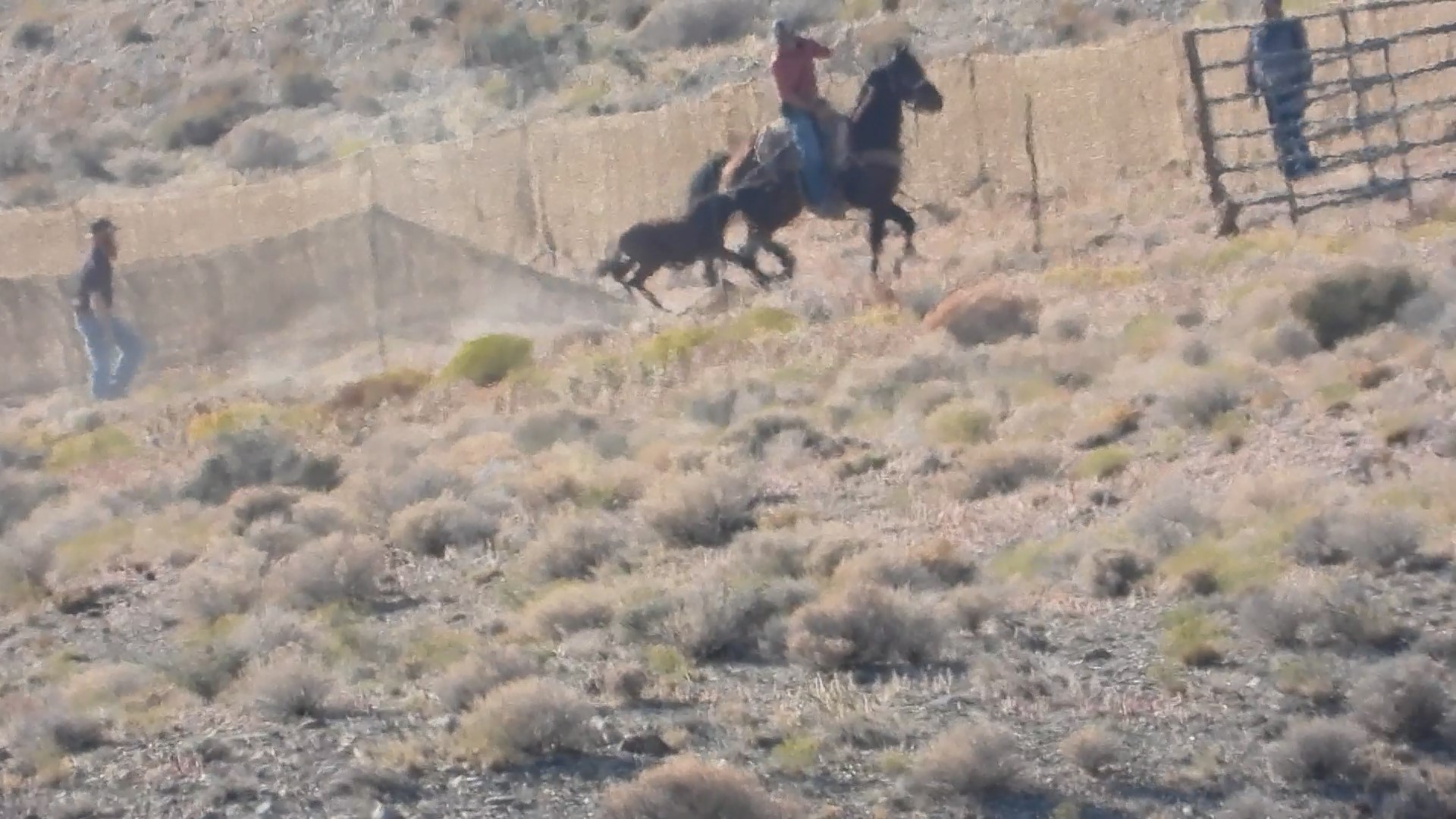
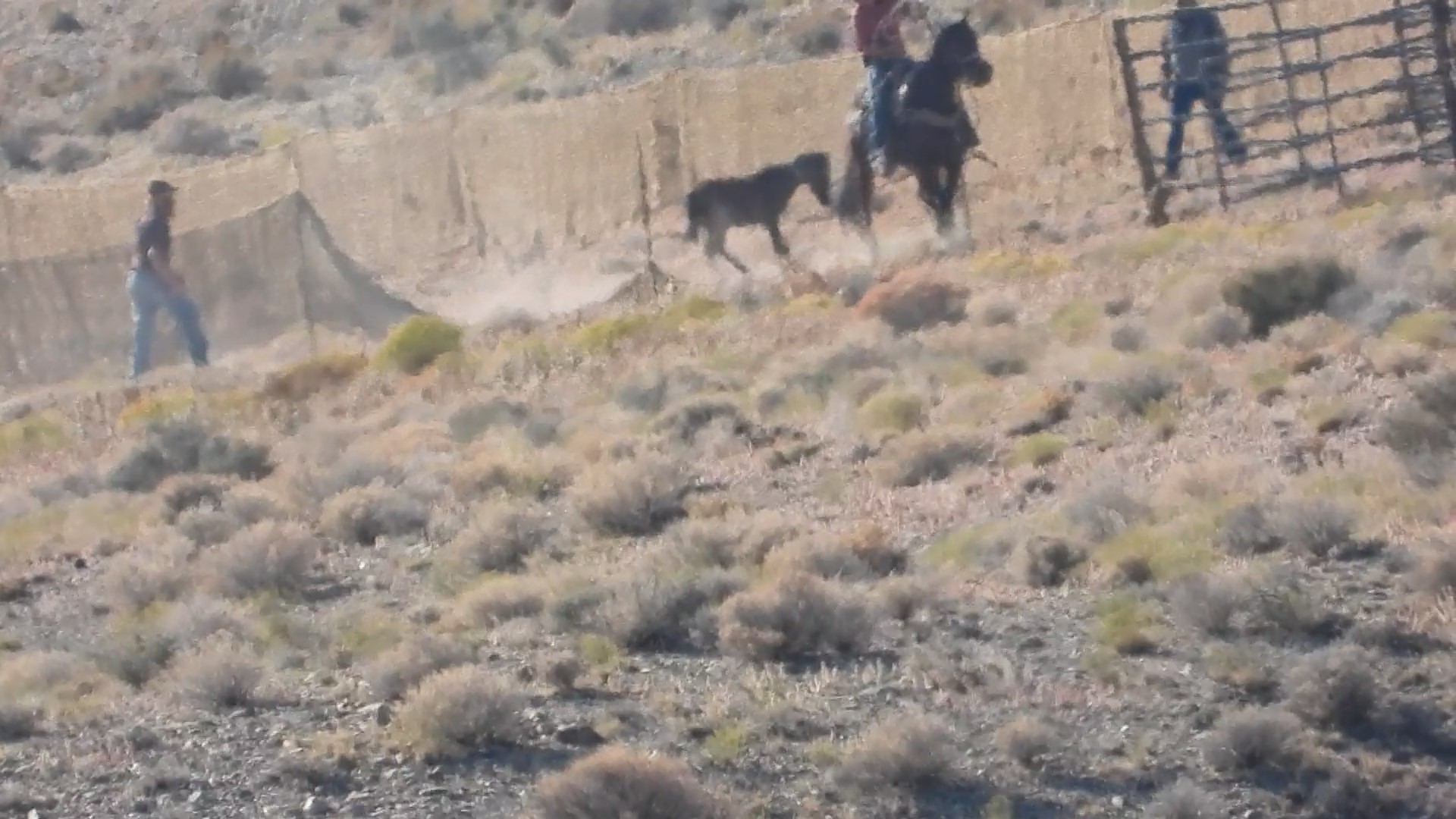
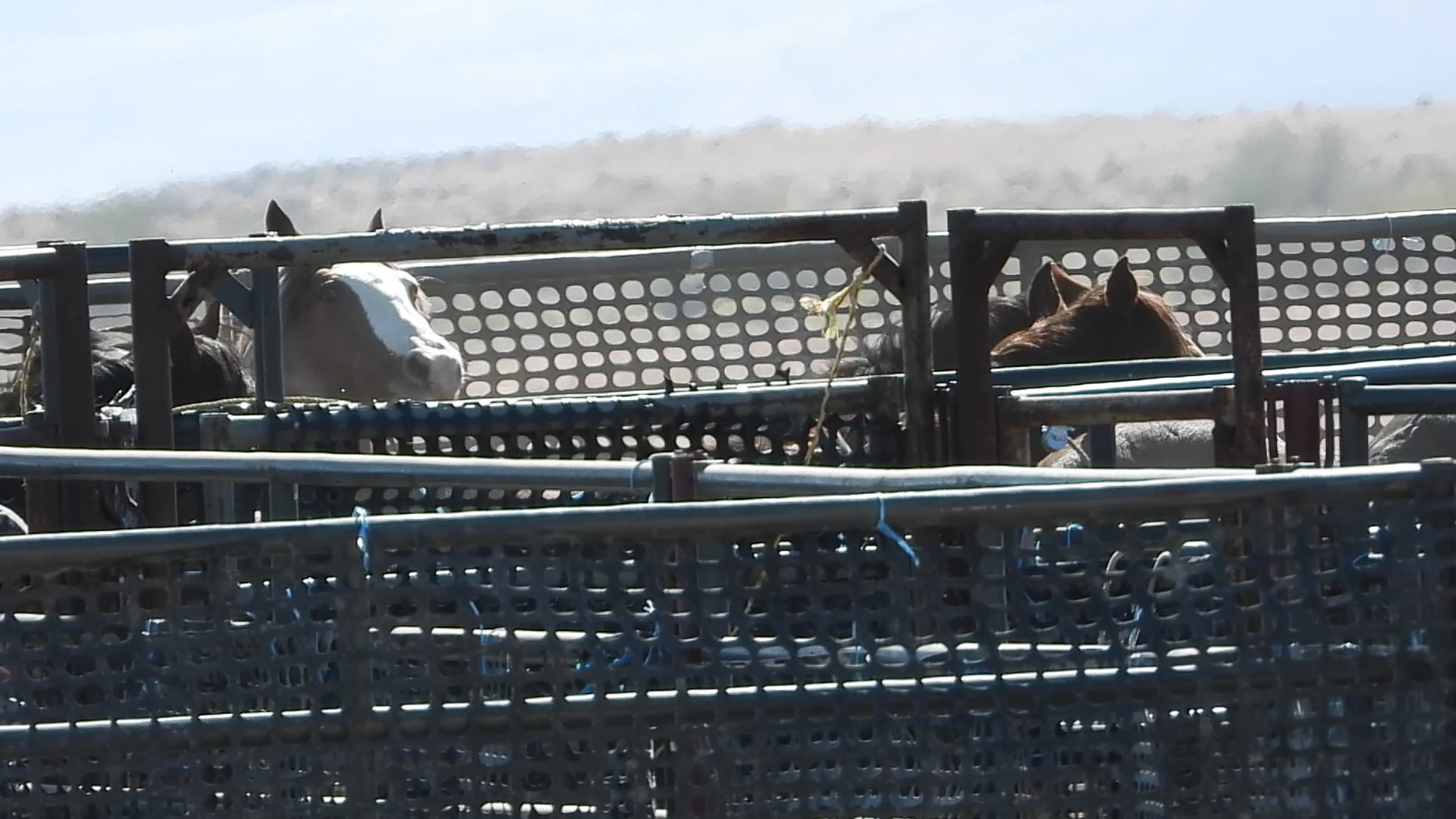
October 20, 2023: 112 wild horses were captured.
At 6am, we met with BLM personnel at Majors Station, located 30 miles East of Ely. From there, we caravaned on Hwy 50 and then turned onto SR 893 up to CR31 until we arrived at the observation site. The observation site and trap were in the same location as the previous day, about 3/4 to 1 mile away.
At the observation site, we were able to see the wings of the trap, the alleyway, a partial view of the catch pen, and the loading area. Depending on the direction the pilot brings the horses in, they have to go through an opening of barbed wire fencing. Part of the jute is hung on the barbed wire fencing, marked by pink flags.
We arrived at the observation site at 7:30 am. The weather was clear with a temperature of 50°. There was one helicopter flying at 7:45 am, which was fueled and made its first run at 8:24 am, rounding up 5 horses, including a foal. At 9:16 am, 9 more horses, including another foal, were brought in. The helicopter refueled at 11:00 am, and at that time, 25 horses came in from the northwest of the observation site. A wrangler went out and roped a foal.
Only the last two runs have been clean runs, except for a foal needing to be roped. At 11:50 am, the pilot brought in 13 horses from the Ridge behind the observation site. The roundup perimeter from the trap, where they are allowed to remove horses, is 10 miles in any given direction. The pilot refueled again at 1:07 pm.
We were waiting to caravan to temporary holding when we were initially told that they were finished for the day and to pack up and head to our vehicles. However, we were then informed that there would be another sweep. The temperature at that time was 80°. I grabbed my camera and walked back up to the observation site, where the pilot brought in another 15 or so horses. The horses were still about one or two miles from the trap, which is a long distance to be running at that pace. The horses appeared to be very sweaty as they were being brought in. Due to heatwaves and dust, some viewing was almost impossible at the trap area. I cannot confirm if the trap was watered for dust abatement, as I did not witness it.
At 2:00 pm, we were told that the pilot had another group of horses to bring in. At 3:00 pm, he brought in another 15 to 17 horses, and the temperature was 81°. At 3:10 pm, I walked back up to the observation site again, and he brought in 5 more horses that had fallen back. This group included a little one that was limping pretty badly going into the wings of the trap.
While walking back to the vehicle, we noticed a truck and trailer with a rider. I had not seen the rider go out prior to that. All the horses that have been rounded up so far have been wild horses outside the Herds Area.
At 4:00 pm, we were waiting to go to temporary holding. We then caravaned 20 miles to temporary holding and arrived at 5:11 pm.
October 19, 2023: 99 wild horses were captured.
October 18, 2023: 42 wild horses were captured.
Yesterday, the trap site was located approximately 1 mile away. We were able to see the Trap and the loading area, but the Catch Pen, alleyway, and wing opening were obstructed by a hill. The trap seemed to be constructed according to CAWP regulations. However, the loading area needed to be dug deeper for proper loading, which was corrected by a second load.
We met with BLM personnel at 5:30 am at Majors Station and traveled together in a caravan. We took Hwy 50 and then turned onto Gandy Rd (a dirt road), heading north. We veered off to the east until we reached the observation point. Today, we are at the same trap/observation location as yesterday. The contractor for this roundup is Cattoor Livestock Roundup Inc. There is one helicopter on site.
Today is what they call a sweep day or clean-up day. This means they sweep the area and remove all the horses before moving the trap. It was a relatively short day. The pilot seemed to focus on the area behind the hill, so most of the runs were obstructed from our view. We witnessed approximately 4 runs today, and one horse was roped by a wrangler, although we couldn't determine if it was a foal or yearling. The body scores of the horses appeared to be between 3-5.
October 17, 2023: 63 wild horses were captured.
We drove about 26 miles to the BLM meet site at Majors Station at 5:30 AM. The temperature was 52°. We then caravanned approximately 43 miles to the Observation site, taking Highway 50 and turning onto Gandy Rd (a dirt road) going North, then veering off to the East until we reached the observation area in the Snake Valley. The trapsite was located approx 1 mile away. The opening of the wings were obstructed by a hill.
The observation site was a short hike from where we parked our vehicles. The BLM AE informed us that they were zeroing out this Horse Area (HA), but approximately 150 wild horses would remain in this HA after the roundup concludes.
Cattoor Livestock Roundup Inc. is the contractor for this roundup, and there is one helicopter on site. The rounded-up horses will be taken to the Southerland Holding Facility in Utah. The trap location is approximately a mile away, and the view of the opening and wings of the trap is restricted by a hill. We could only see a small part of the alleyway and had a full view of the trap and loading area.
The trap appears to be constructed according to CAWP regulations. All trucks and trailers seem to be well-maintained and in working order. The flight parameter for this roundup is 10 miles. The temporary holding area is located just a few miles from the trap area.
At 8:15, the first 5 horses were brought in. On the second run at 9:20, the pilot brought in some horses from behind us as they traveled across the valley and got closer to going down into the knoll. Two horses split off and evaded the trap. It was hard to see exactly how many horses came in.
There was a foal in the foal trap from the first run that seemed to be getting a little panicked as the horses from the second run came in. The pilot refueled and then headed out. Two trailers left for temporary holding, including the foal. At 11:23, the pilot came in to refuel, and at 11:28, the helicopter was back in the air.
At 11:59, two trailers went to temporary holding. At 1:30, the helicopter refueled. The pilot has been working the same area for approximately an hour now. I can see him on the top of the ridge going back and forth, but no horses have come into view.
At 1:50, the pilot brought in approximately 15 to 20 horses out of the trees. He then headed back out towards that same area but came back in and landed. At 2:44, the pilot called it a day, packed up, and headed to the short-term holding area. The temperature at that time was 72°.
